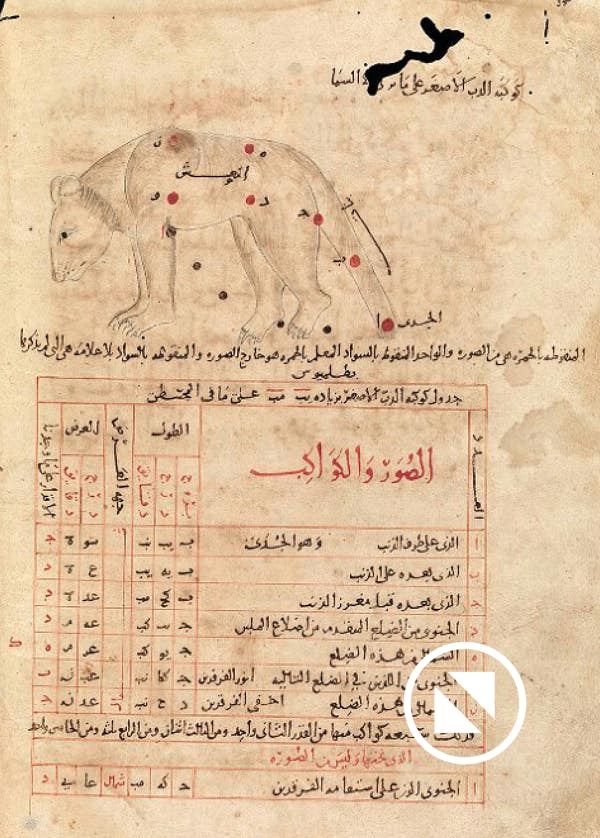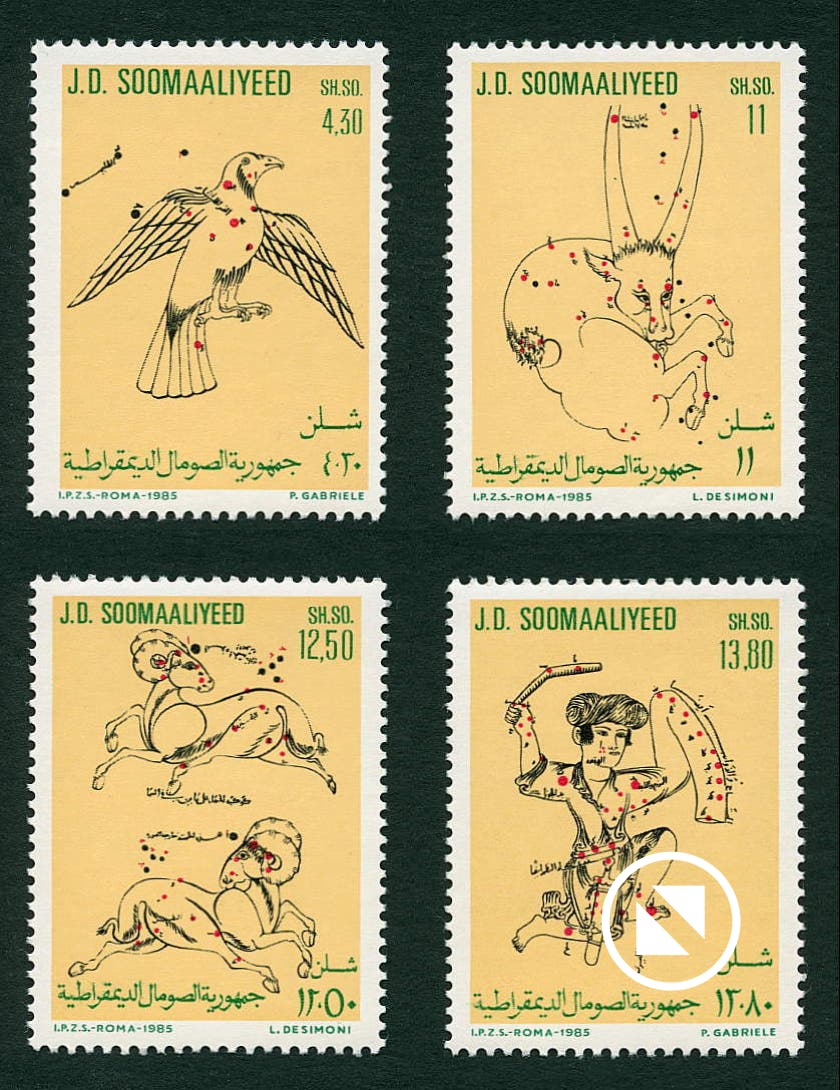al-Sufi’s constellations
A 10th-century Arabic astronomer
who kept alive the Ptolemaic tradition
ALL astronomers know the names of Ptolemy, Tycho Brahe, and Johannes Hevelius, three landmark characters who catalogued the stars with ever-increasing accuracy between the second and seventeenth centuries. Less familiar in the West, but no less influential, is the tenth-century Persian astronomer Ἁbd al-Raḥmān al-Ṣūfī (903–986), usually known simply as al-Ṣūfī, or Azophi in Latinized form.[note] Al-Ṣūfī was the Arabic successor to Ptolemy at a time when the Greek tradition in astronomy had died out in the West but was being rediscovered in the Middle East.
Al-Ṣūfī, who ran an observatory in the Persian city of Shīrāz (now in Iran), used the star catalogue in Ptolemy’s Almagest as the basis for his own Arabic version called Kitāb al-Kawākib al-Thābita, i.e. Book of the Fixed Stars. This appeared in or shortly after AD 964, some eight hundred years after the original Almagest was written. Al-Ṣūfī’s book, the first-ever updating of the Almagest, became the standard constellation handbook for several centuries thereafter, inspiring the development of Arabic astronomy and eventually aiding the transmission of Greek astronomy back into the West. Al-Ṣūfī was one of the four ancient authorities credited on the first European printed star charts produced by Albrecht Dürer in 1515.
A meeting of Greek and Arabic traditions
Like all books in the days before printing, the Book of the Fixed Stars was written and illustrated by hand. Further copies had to be hand-made too, and each copy was unique and prone to loss or damage. Al-Ṣūfī’s original manuscript has disappeared, but we still have an early copy reputedly made by his son Ibn al-Ṣūfī and thought to date from 24 years after his father’s death, although some scholars consider it a much later copy by a different author. One of the great treasures of astronomical history, this manuscript is kept in the Bodleian Library, Oxford, where it is catalogued as Marsh 144; it can be seen online here. Ibn al-Ṣūfī also wrote a poem about the stars based on the book called Urjūza fī’l-kawākib, thereby helping to popularize his father’s work.
Al-Ṣūfī’s book retained the same 48 constellations and their component stars as in the Almagest, but in the accompanying text he added information about traditional Bedouin Arabic constellation figures and Arabic star names. Most of the book consists of discussions of the constellations and their stars in Greek and Arabic tradition. The first English translation of the Book of the Fixed Stars was published in 2013 by Ihsan Hafez of James Cook University, Australia.
Arabic names for Ptolemy’s constellations were mostly a literal description of the Greek figure: for example, Andromeda was al-mar’a al-musalsala, i.e. ‘the chained woman’, Auriga was mumsik al-a’ ‘inna, ‘he who holds the reins’, and Perseus was hāmil ra’s al-ghūl, ‘bearer of the demon’s head’. Aratus’s Phaenomena had been translated into Arabic in the early 9th century, and so the Arabs of al-Ṣūfī’s day were familiar with Greek constellation mythography as well as their astronomy.
Constellation illustrations
To the casual viewer, the main attraction of the book is the constellation illustrations, something that the original Almagest notably lacked. Each constellation was depicted twice, first in mirror image, as it would appear on a celestial globe, and secondly as it actually appears in the sky. Unlike on modern charts no coordinates were shown, so there was no sense of scale and no indication which way north was.
The human constellation figures are depicted in Islamic style. One intriguing divergence from the classical Greek iconography is that of Perseus, in which the head of Medusa has become a bearded man. Possibly the Arabs had seen European depictions of Medusa’s head known as gorgoneia and misinterpreted the Gorgon’s dangling snake hair as a beard. A detailed study of Arab constellation iconography can be found here.
al-Ṣūfī’s Ursa Minor
This diagram of Ursa Minor with a table of its constituent stars comes from what is reputedly the oldest surviving copy of al-Ṣūfī’s Book of the Fixed Stars, dating from 1009–10. In a departure from the western tradition, the bear is oriented with its feet pointing towards Ursa Major, so that its tail droops down.
The table lists the same seven stars that Ptolemy catalogued in his Almagest. These seven are known today as Alpha (Polaris), Delta, Epsilon, Zeta, Eta, Beta, and Gamma Ursae Minoris. They are shown in red on the constellation diagram, with black labelling.
On the bottom line of the table is a star that Ptolemy described as being ‘outside’ the constellation; we now know this star as 5 Ursae Minoris. It is shown on the diagram as a black dot with a red identifying number. Four other stars under the body of the bear are plotted on the diagram in black. These come from al-Ṣūfī’s own observations, but are not labelled on the chart or listed in the table because they were not recorded by Ptolemy.
Reading from the right, the columns in the table show the number of the star in the order listed by Ptolemy, a description of its position in the constellation, its coordinates, and magnitude. Al-Ṣūfī has corrected two of Ptolemy’s magnitudes, changing Eta UMi from magnitude 4 to just brighter than 5 and Gamma UMi from mag 2 to 3. However, he has accepted Ptolemy’s estimate of Alpha UMi (Polaris) as magnitude 3, when it is in fact 2.
(Bodleian Library, Oxford, manuscript Marsh 144)
On the charts of manuscript Marsh 144, the stars that Ptolemy had regarded as forming a given constellation are drawn as red dots with black labelling, in some cases including their names; while those stars that Ptolemy listed as lying outside the main constellation figures – the so-called ‘unformed’ stars – are in black with red numbers. Later copies of al-Ṣūfī’s book used different colour schemes for the stars and labelling.
As well as plotting Ptolemy’s individual stars and three nebulae from the Almagest, al-Ṣūfī inserted more than 40 stars on the charts from his own observations. In Marsh 144 these are drawn in black, without accompanying numbers because they were not part of the star catalogue. Look, for example, at al-Ṣūfī’s chart of Cepheus. The two ‘unformed’ stars that Ptolemy described as lying on each side of the King’s head-dress (now known as Delta and Mu Cephei) can clearly be seen in black; but as well as those, al-Ṣūfī has added another five stars of his own in and around Cepheus’s left leg and four more near his right elbow creating a circle with two Ptolemaic stars.
Each of al-Ṣūfī’s charts was accompanied by a table of stars that closely followed the listing in the Almagest (for an example of a star table from the Almagest see here). Al-Ṣūfī repeated Ptolemy’s description of each star’s position in the constellation figure, and he also added Arabic names for the stars where he knew of them.
The tables give the celestial latitude and longitude of each star for AD 964, the year in which the book was written. These coordinates came not from new observation but simply by adjusting Ptolemy’s figures by a calculated amount to account for precession. Al-Ṣūfī did, though, use his own observations to correct the magnitudes of about half the stars in the lists. None of al-Ṣūfī’s own stars were incorporated into the tables, which were restricted to Ptolemy’s original listings. It is clear that a guiding factor in the book was, as far as possible, the preservation and continuation of the Ptolemaic tradition.
Al-Ṣūfī’s nebulae
Al-Ṣūfī’s book contains the first known record of three nebulous objects not mentioned by Ptolemy: the Andromeda Galaxy; Brocchi’s Cluster (the Coathanger); and the Omicron Velorum Cluster (IC 2391). These objects are mentioned only in al-Ṣūfī’s text, and are not in the star tables, although the Andromeda Galaxy is shown in one of the accompanying illustrations. It is surprising that the Andromeda Galaxy was not recorded by the Greeks, as it is an easy naked-eye object under dark skies.
R. H. Allen, in his book Star Names, Their Lore and Meaning, credits al-Ṣūfī with a mention of the Large Magellanic Cloud, but this is a misunderstanding by Allen of a reference to some stars in southern Argo Navis; the Magellanic Clouds were actually too far south to be seen from al-Ṣūfī’s observatory at Shiraz, latitude 29.6°N. In reality, the Arabs did not learn of the Magellanic Clouds until the end of the 15th century from the master navigator Ahmad ibn Mājid (c.1430–c.1500) only shortly before they became known in the west.
Surviving copies
We can never know how many copies of the Book of the Fixed Stars were made over the years, but over 90 are currently preserved in museums and libraries around the world. Each has its own individual features, because each copyist introduced their own version of the constellation figures, influenced by local style and tradition.
One of the most celebrated copies is one that was made in the 1430s and originally belonged to the great Muslim astronomer Ulugh Beg (1394–1449). This is now kept at the Bibliothèque Nationale de France and is known as MS Arabe 5036.[note] Working at his own observatory in Samarkand, in modern Uzbekistan, Ulugh Beg reobserved the stars of the Almagest to produce the Zīj-i jadīd-i Sultānī, published in 1437, the most accurate star catalogue prior to that of Tycho Brahe, although it lacked the popular appeal of al-Ṣūfī’s illustrated version.
Al-Ṣūfī’s constellations
on postage stamps
In 1985, the east African country of Somalia issued this set of four stamps containing constellation illustrations of Aquila, Taurus, Aries, and Orion from al-Ṣūfī’s Book of the Fixed Stars.
The illustrations have clearly been redrawn from those in the manuscript known as Marsh 144, kept in the Bodleian Library, Oxford.
Taurus is shown back-to-front, as it appears on a celestial globe. Aquila and Orion are the right way round, as seen in the sky, although Aquila has been inverted so that south is at the top. Both versions of Aries are shown, with the constellation appearing as on a globe at top and as in the sky underneath.
For collectors, the reference numbers of the stamps as listed in the Stanley Gibbons stamp catalogue are Somalia 730–733.
© Ian Ridpath. All rights reserved
The origin of the name Azophi is attributed to the 12th-century Spanish-Jewish scholar Abraham ibn Ezra, who studied al-Ṣūfī’s works. Ibn Ezra is also known as Abenezra and, as it happens, on the Moon the craters Abenezra and Azophi lie adjacent to each other.
A depiction of Cancer from MS Arabe 5036 featured in a Google Doodle in 2016 that commemorated the 1113th birthday of al-Ṣūfī.


